1992 VOLKSWAGEN TRANSPORTER Page 97
[x] Cancel search: Page 97Page 80 of 164
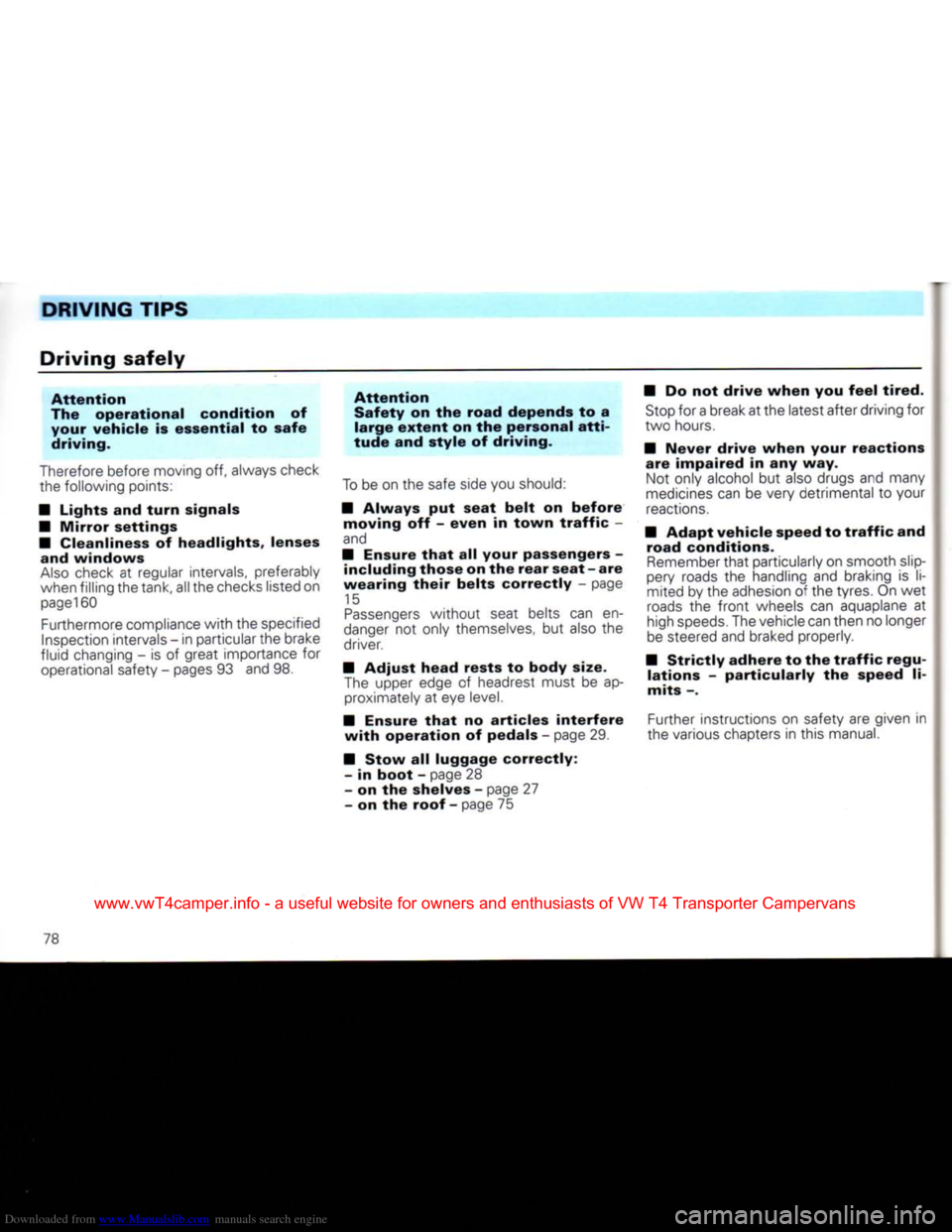
Downloaded from www.Manualslib.com manuals search engine
DRIVING
TIPS
Driving
safely
Attention
The
operational
condition of your
vehicle
is
essential
to
safe
driving.
Therefore before moving off, always check
the following points:
• Lights and
turn
signals
•
Mirror
settings
• Cleanliness of
headlights,
lenses and
windows
Also
check at regular intervals, preferably
when filling the tank, all the checks listed on
page160
Furthermore compliance
with
the specified Inspection intervals - in particular the brake
fluid changing - is of great importance for operational safety - pages 93 and 98.
Attention
Safety
on the
road
depends to a
large
extent
on the personal
atti
tude
and
style
of driving.
To
be on the safe side you should:
•
Always
put
seat
belt
on
before
moving
off -
even
in
town
traffic
-
and
• Ensure
that
all your passengers - including
those
on the
rear
seat
- are
wearing
their
belts
correctly
- page
15
Passengers
without seat belts can en
danger
not only themselves, but also the
driver.
•
Adjust
head
rests
to body size.
The
upper edge of headrest must be approximately at eye
level.
• Ensure
that
no
articles
interfere
with
operation
of pedals - page 29
•
Stow
all
luggage
correctly:
- in
boot
- page 28
- on the shelves - page 27
- on the
roof
- page 75 • Do not
drive
when
you
feel
tired.
Stop
for a break at the latest after driving for
two hours.
•
Never
drive
when
your
reactions
are
impaired
in any way. Not only alcohol but also drugs and many
medicines
can be very detrimental to your
reactions.
•
Adapt
vehicle
speed to
traffic
and
road
conditions.
Remember
that
particularly on smooth slip
pery roads the handling and braking is li
mited by the adhesion of the tyres. On wet
roads
the
front
wheels can aquaplane at
high
speeds.
The vehicle can then no longer
be
steered and braked properly.
•
Strictly
adhere
to the
traffic
regu
lations
-
particularly
the speed li
mits
-.
Further instructions on safety are given in
the various chapters in this manual.
78
www.vwT4camper.info - a useful website for owners and enthusiasts of VW T4 Transporter Campervans
Page 82 of 164

Downloaded from www.Manualslib.com manuals search engine
DRIVING
TIPS
The technical
prerequisites
"or
a low fuel consumption and efficiency were "built in" at the factory. Particular im
portance was placed on the lowest possible
disturbance
to the environment. To retain
and
make the best possible use of these
characteristics
attention should be paid to
the following points:
Vehicles
fitted
with
a
catalytic
converter
may
only
be
driven
on
unleaded
petrol.
Even
those
vehicles
which
do
not
have
a
catalytic
converter
should
be
driven
on
unleaded
petrol
for the
sake
of the
environment.
The
prescribed
maintenance
operations
should
be
carried
out
exactly
as
specified
in the
Service
Schedule - see
also
page
93.
Having your vehicle regularly serviced by
a Volkswagen dealer not
only
ensures
that
it is always operationally fit, but it
also ensures economy, lowest possible burden on the environment and a long
service
life.
Check the
tyre
pressures
every
4
weeks.
Low
tyre
pressures increase the rolling
resistance.
This not
only
increases the
fuel
consumption and
tyre
wear,
but the
handling is also impaired.
Do not
carry
unnecessary
ballast
in the
luggage
boot
Particularly in
town
traffic
when one has to accelerate
often,
weight
has a
great
in
fluence on the
fuel
consumption. As a
rule
of
thumb:
For every 100 kg of
weight
the consumption increases by approxi
mately
litre
per 100 km.
Remove
roof
rack
immediately
after
use
Particularly at
high
speeds the increased
air resistance makes
itself
felt
consider
ably.
gCK
Electrical
consumers
should
only
be
switched
on
when
they
are
actually
required
Heated rear windows, additional driving
lights
and heater blower consume a con
siderable amount of
current.
The higher
alternator
load
also increases the
fuel
consumption. For instance, over a period of 10 hours, the heated rear window
will
increase
the
fuel
consumption by ap
proximately 1
litre.
Check the
fuel
consumption
reg
ularly
The
fuel
consumption should be checked
each
time
the
tank
is
filled
up. By doing
this
inconsistencies on the vehicle which
lead to an increased
fuel
consumption
can be discovered sooner.
• Check the
engine
oil
level
each
time
the
tank
is
filled
up
The
oil consumption depends to a great ex
tent
on the engine load and
speed.
Depend
ing on the style of driving the consumption
can
be as much as 1.0 litres/1000 km.
It is normal for the oil consumption of a new
engine
to reach its lowest level after a cer
tain mileage has been covered. The
con
sumption cannot be properly
assessed
until
the vehicle has run approx. 5000 km.
This
also
applies to the fuel consumption
and
the engine output.
www.vwT4camper.info - a useful website for owners and enthusiasts of VW T4 Transporter Campervans
Page 83 of 164
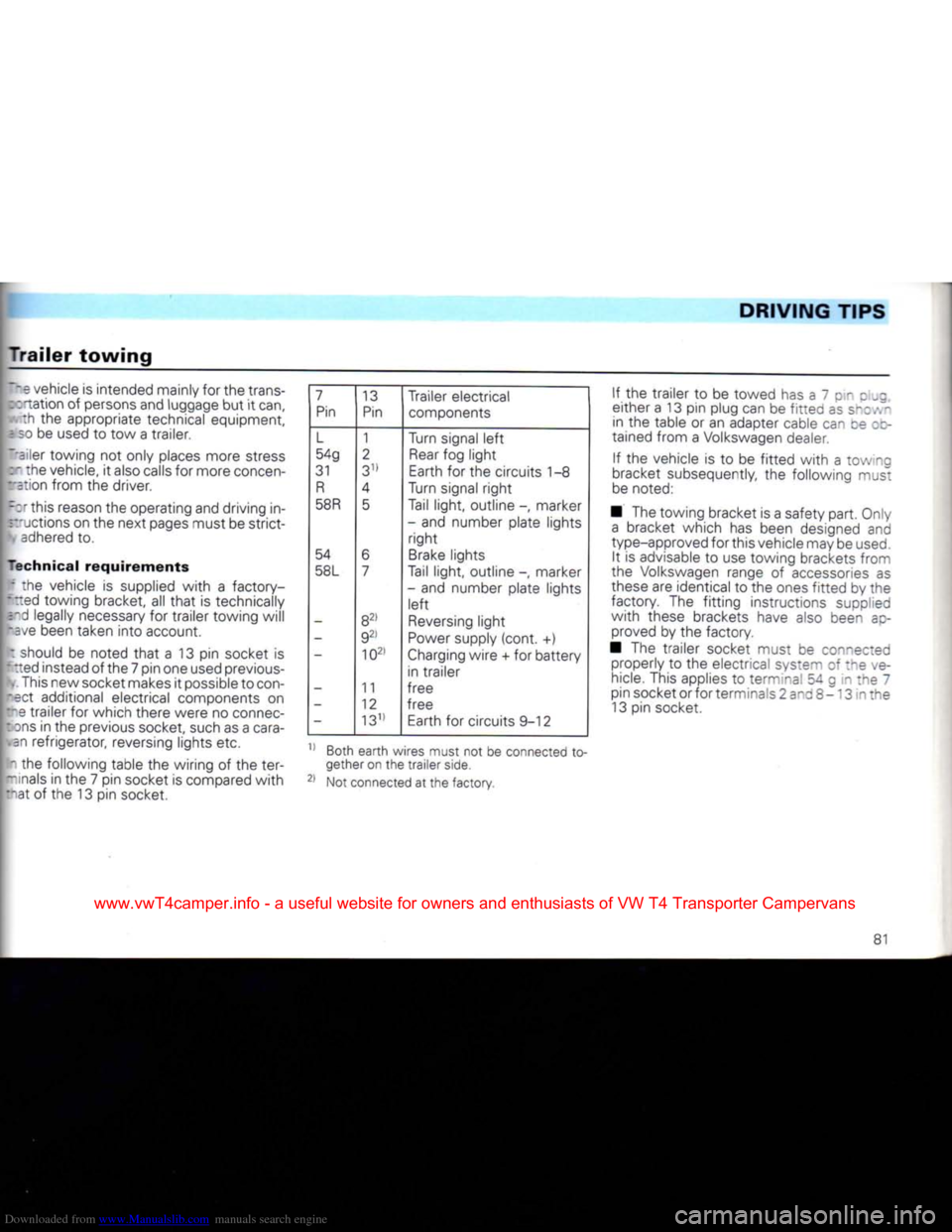
Downloaded from www.Manualslib.com manuals search engine
DRIVING
TIPS
Trailer
towing
~~e
vehicle is intended mainly for the trans-
cctation of persons and luggage but it can, th the appropriate technical equipment,
=
so be used to tow a trailer.
Ibiler towing not only places more stress : - the vehicle, it also calls for more concen-
ration from the driver.
::r this reason the operating and driving inductions on the next pages must be strict- . adhered to.
Technical
requirements
" :he vehicle is supplied
with
a factory-
• ::ed towing bracket, all
that
is technically -
d
legally necessary for trailer towing will =ve been taken into account.
: should be noted
that
a 13 pin socket is
::ed
instead of the 7 pin one used previous- . This new socket makes it possible to con-
ect additional electrical components on trailer for which there were no connec-
ns
in the previous socket, such as a
cara-
n refrigerator, reversing lights etc.
the following table the wiring of the ter-
nals
in the 7 pin socket is compared
with
at of the 13 pin socket.
I a 7
13
Trailer electrical
Pin Pin
components
L
1 Turn signal
left
54g
2
Rear
fog light
31
311
Earth
for the circuits 1-8
R
4
Turn signal
right
58
R
5
Tail
light, outline -, marker
- and number plate lights
right
54 6
Brake
lights
58L
7
Tail
light, outline -, marker
- and number plate lights
left
- 82>
Reversing
light
-
92!
Power
supply (cont. +)
-
102!
Charging
wire + for battery
in trailer
- 11
free
- 12
free
-
1311
Earth
for circuits 9-12
1) Both earth wires must not be connected to gether on the trailer side.
21 Not connected at the factory. If the trailer to be towed has a 7 pin plug,
either a 13 pin plug can be
fitted
as shown
in the table or an adapter cable can ce zz-
tained from a Volkswagen dealer.
If the vehicle is to be
fitted
with
a towing
bracket subsequently, the following must
be
noted:
• The towing bracket is a safety part. Only
a
bracket which has been designed and
type-approved for this vehicle may be
used.
It is advisable to use towing brackets from
the Volkswagen range of accessories as
these
are identical to the ones
fitted
by the
factory. The
fitting
instructions supplied
with
these brackets have also been ap proved by the factory.
• The trailer socket must be connected properly to the electrical system of the ve
hicle.
This applies to terminal 54 g in the 7
pin socket or for terminals 2 and 8 -13 in the
13
pin socket.
81
www.vwT4camper.info - a useful website for owners and enthusiasts of VW T4 Transporter Campervans
Page 84 of 164
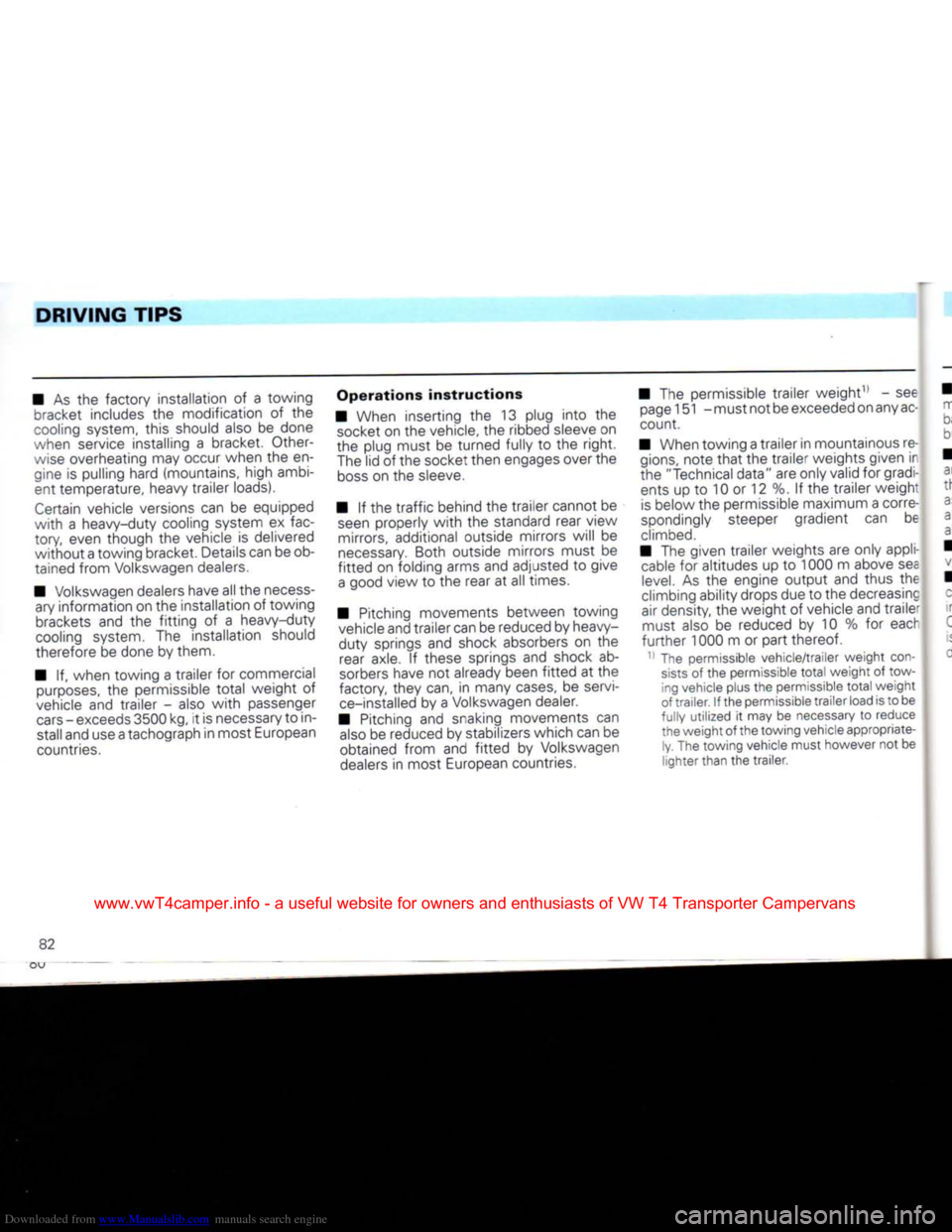
Downloaded from www.Manualslib.com manuals search engine
DRIVING
TIPS
• As the factory installation of a towing bracket includes the modification of the
cooling
system, this should also be done
when service installing a bracket. Other
wise
overheating may occur when the en gine is pulling hard (mountains, high ambi
ent temperature, heavy trailer loads).
Certain
vehicle versions can be equipped
with
a heavy-duty cooling system ex fac
tory,
even though the vehicle is delivered
without
a towing bracket. Details can be ob
tained from Volkswagen dealers.
• Volkswagen dealers have all the
necess
ary information on the installation of towing
brackets
and the
fitting
of a heavy-duty
cooling
system. The installation should
therefore be done by them.
• If, when towing a trailer for commercial
purposes,
the permissible
total
weight of
vehicle
and trailer - also
with
passenger
cars
- exceeds 3500 kg, it is necessary to in
stall and use a tachograph in most European
countries.
Operations
instructions
• When inserting the 13 plug
into
the
socket
on the vehicle, the ribbed sleeve on
the plug must be turned fully to the
right.
The
lid of the socket then engages over the
boss
on the
sleeve.
• If the
traffic
behind the trailer cannot be
seen
properly
with
the standard rear view mirrors, additional outside mirrors will be
necessary.
Both outside mirrors must be
fitted
on folding arms and adjusted to give
a
good view to the rear at all times.
• Pitching movements between towing
vehicle
and trailer can be reduced by heavy-
duty springs and shock absorbers on the rear axle. If these springs and shock ab
sorbers
have not already been
fitted
at the
factory, they can, in many
cases,
be servi
ce-installed
by a Volkswagen dealer.
• Pitching and snaking movements can
also
be reduced by stabilizers which can be
obtained from and
fitted
by Volkswagen
dealers
in most European countries. • The permissible trailer weight11 - see
page
151 -must not be
exceeded
on any
ac
count.
• When towing a trailer in mountainous re
gions,
note
that
the trailer weights given ir
the "Technical data" are only valid for gradi ents up to 10 or 12 %. If the trailer weigh'
is
below the permissible maximum a corre
spondingly steeper gradient can be
climbed.
• The given trailer weights are only appli
cable
for altitudes up to 1000 m above see
level.
As the engine
output
and thus the
climbing ability drops due to the decreasing
air density, the weight of vehicle and trailer must also be reduced by 10 % for eacr
further
1000 m or part thereof.
1 The permissible vehicle/trailer weight
con
sists
of the permissible
total
weight of towing vehicle plus the permissible
total
weight
of trailer. If the permissible trailer load is to be
fully utilized it may be necessary to reduce
the weight of the towing vehicle appropriate ly. The towing vehicle must however not be
lighter than the trailer.
82
www.vwT4camper.info - a useful website for owners and enthusiasts of VW T4 Transporter Campervans
Page 85 of 164

Downloaded from www.Manualslib.com manuals search engine
DRIVING
TIPS
• Where possible make
full
use of the maximum permissible drawbar weight on
call
of the towing bracket - see page 151 -
cut do not exceed it.
• While observing the permissible trailer
and
drawbar weight, distribute the load in
the trailer so
that
heavy objects are as near
as
possible to the axle. The objects must
a
so be secured so
that
they cannot slip
aoout.
• Check the
tyre
pressures on the towing
/ehicle
and the trailer.
• The headlight settings, should be
:hecked
with
trailer attached before mov- ng off and adjusted as necessary.
On
vehicles
with
headlight beam control it
is
only necessary to
turn
the knurled disc in
:ash
in the appropriate direction.
Driving
instructions
To
obtain the best possible handling of ve
hicle
and trailer, the following should be
noted:
• Try to avoid driving
with
an unladen ve
hicle
and a loaded trailer. If this cannot be
avoided,
only drive slowly to allow for the unfavourable weight distribution.
• As driving stability of vehicle and trailer
decreases
when the speed increases do not
drive at the maximum permissible top
speed
in unfavourable road, weather or
wind conditions - particularly when going downhill. In any
case
the speed must be reduced im
mediately the trailer shows the slightest
sign
of snaking. On no account try to stop
the snaking by accelerating.
• For safety reasons one should not drive faster than 80 km/h (50 mph). This also
applies
in countries where higher speeds
are permitted. • Always brake in good time. If the trailer
has
an overrun brake, apply the brakes gen
tly at
first
then firmly. This will avoid the
jerk
ing caused by the trailer wheels locking.
Change
down before going down a steep hill so
that
the engine can act as a brake.
• When a long climb in a low gear
with
ex tremely high engine revs must be nego
tiated at exceptionally high ambient temperatures the coolant temperature gauge must be observed. When the gauge needle
moves
to the
>~zza'
e~z of :ne
scale,
the road speed must be reduced immediately. If nevertheless ~g amp flashes,
stop immediately and si ow the engine to
cool
off at idling speed for several minutes.
• The cooling effect of the radiator fan
can
not be increased by changing down, be
cause
the speec of t~e
~a~
s ~o! dependent
on the engine
speed.
One should therefore not change down even when towing a
trailer as long as :-e e-g -e zar cope with out the vehicle speed dropping too much.
83
www.vwT4camper.info - a useful website for owners and enthusiasts of VW T4 Transporter Campervans
Page 86 of 164
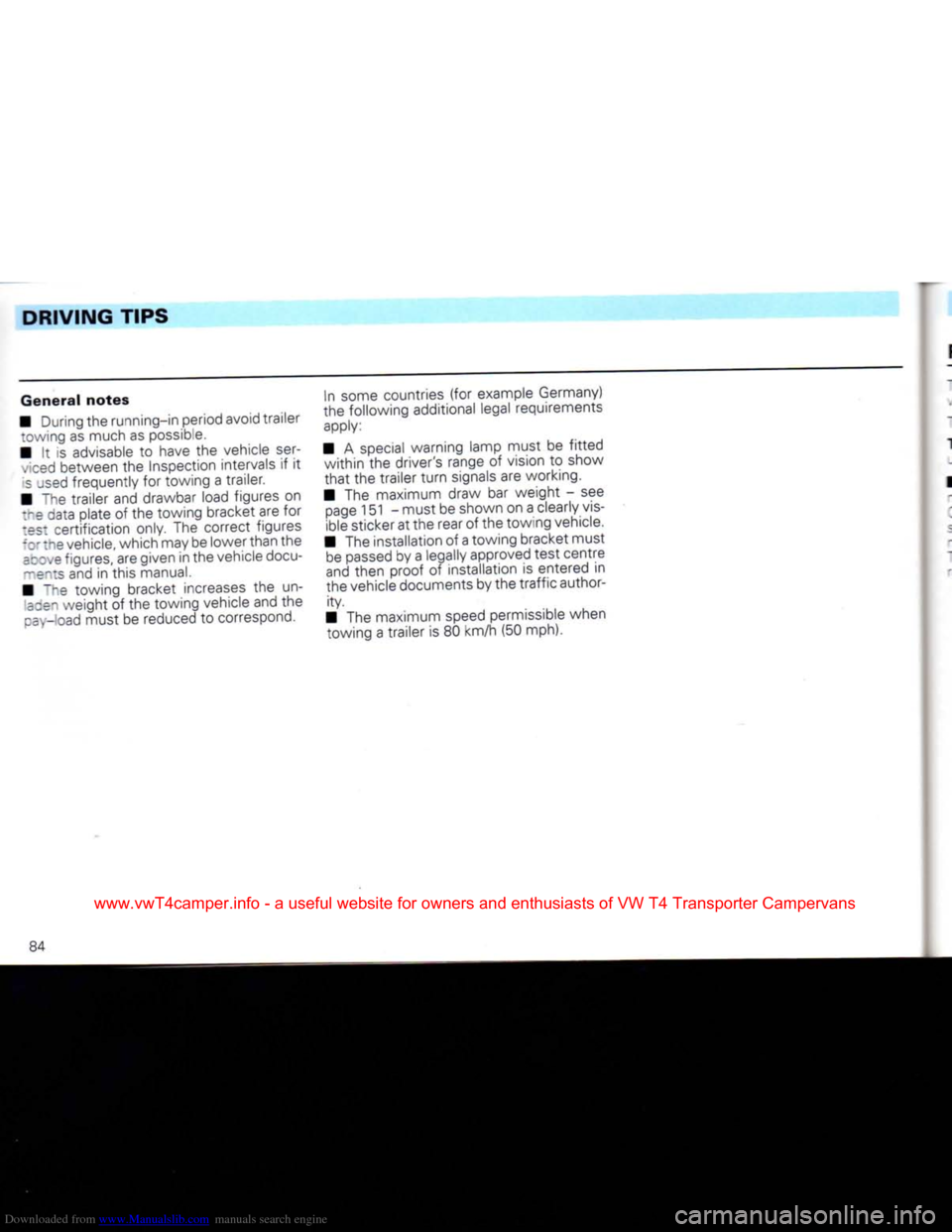
Downloaded from www.Manualslib.com manuals search engine
DRIVING
TIPS
General
notes
• During the running-in period avoid trailer "owing as much as possible.
• It is advisable to have the vehicle ser-
.ced
between the Inspection intervals if it
s
used frequently for towing a trailer.
• ""he trailer and drawbar load figures on
:re
data plate of the towing bracket are for
:es:
certification only. The correct figures
forthe
vehicle, which may be lower than the
acove
figures, are given in the vehicle docu-
~e~:s
and in this manual.
• The towing bracket increases the un-
535"
weight of the towing vehicle and the
pay-load
must be reduced to correspond. In some countries (for example Germany)
the following additional legal requirements
apply:
• A special warning lamp must be
fitted
within
the driver's range of vision to show
that
the trailer
turn
signals are working.
• The maximum draw bar weight - see
page
151 - must be shown on a clearly
vis
ible sticker at the rear of the towing vehicle.
• The installation of a towing bracket must
be
passed by a legally approved test centre
and
then proof of installation is entered in
the vehicle documents by the
traffic
author ity.
• The maximum speed permissible when towing a trailer is 80 km/h (50 mph).
84
www.vwT4camper.info - a useful website for owners and enthusiasts of VW T4 Transporter Campervans
Page 91 of 164
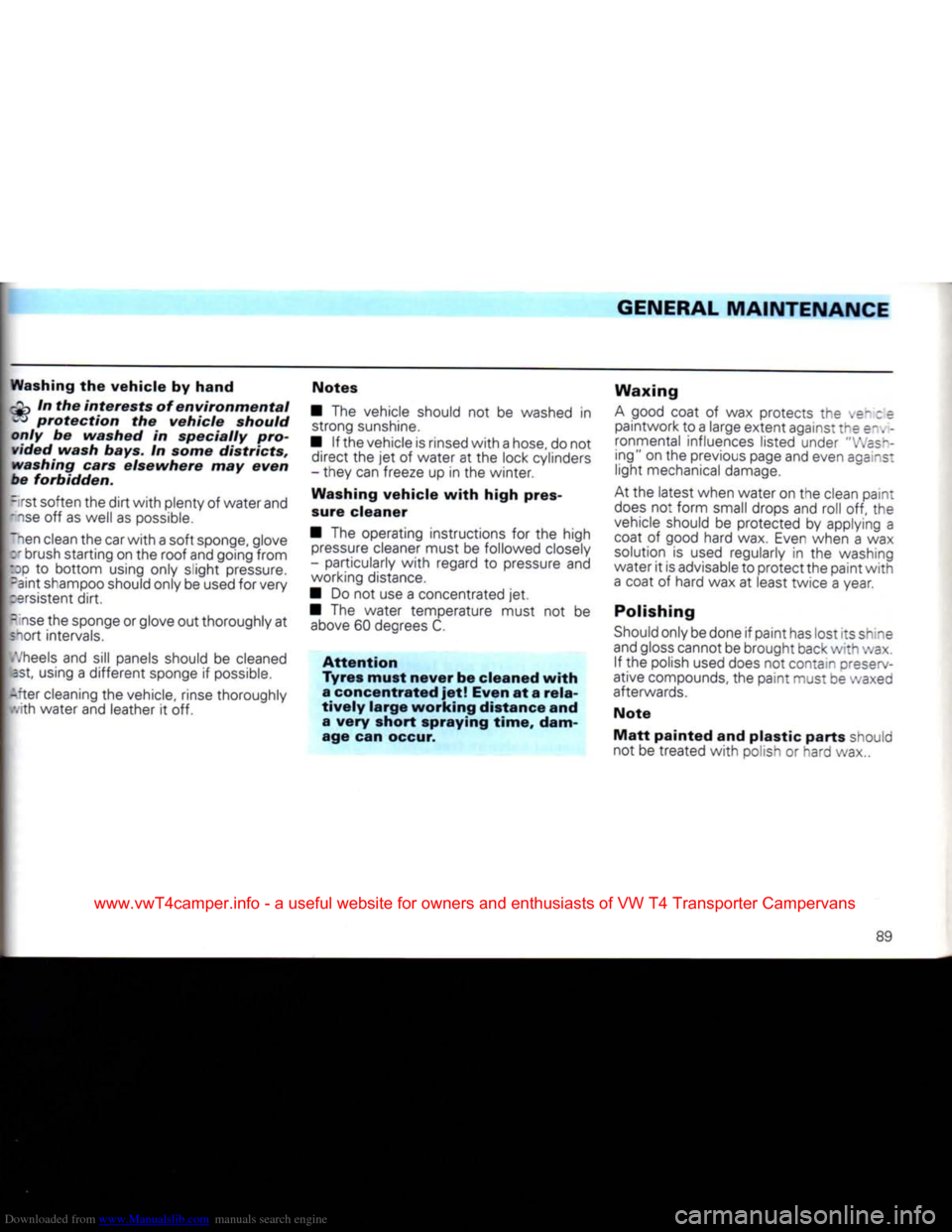
Downloaded from www.Manualslib.com manuals search engine
GENERAL
MAINTENANCE
Washing
the
vehicle
by
hand
In the
interests
of
environmental
B
protection
the
vehicle
should
only
be
washed
in
specially
pro
vided
wash
bays.
In
some
districts,
washing
cars
elsewhere
may
even
be
forbidden.
Irst
soften the
dirt
with
plenty of water and
-ise
off as well as possible.
~nen clean the car
with
a soft sponge, glove
or brush starting on the roof and going from :3p to bottom using only slight pressure. :aint shampoo should only be used for very
cersistent
dirt.
=
:nse
the sponge or glove out thoroughly at
snort intervals.
.'.'heels
and sill panels should be cleaned
last, using a different sponge if possible.
After cleaning the vehicle, rinse thoroughly
vith
water and leather it off.
Notes
• The vehicle should not be washed in strong sunshine.
• If the vehicle is rinsed
with
a
hose,
do not direct the jet of water at the lock cylinders
- they can freeze up in the winter.
Washing
vehicle
with
high
pres
sure
cleaner
• The operating instructions for the high
pressure
cleaner must be followed closely
- particularly
with
regard to pressure and working distance.
• Do not use a concentrated jet. • The water temperature must not be above 60 degrees C.
Attention
Tyres
must
never
be
cleaned
with
a
concentrated
jet! Even at a
rela
tively
large
working
distance
and a
very
short
spraying
time,
dam
age can occur.
Waxing
A
good coat of wax protects the .s~ : e
paintwork to a large extent against the e". -
ronmental influences listed under
"Wash
ing"
on the previous page and even agars:
light
mechanical damage.
At the latest when water on the clean paint
does
not form small drops and roll off, the
vehicle should be protected by applying a
coat of good hard wax.
Even
when a wax solution is used regularly in the washing
water it is advisable to protect the paint
with
a
coat of hard wax at least twice a year.
Polishing
Should
only be done if paint has lost its shine
and gloss cannot be brought back
with
wax. If the polish used does not contain preserv
ative compounds, the paint must oe waxed
afterwards.
Note
Matt
painted
and
plastic
parts
should not be treated
with
polish or hard wax..
89
www.vwT4camper.info - a useful website for owners and enthusiasts of VW T4 Transporter Campervans
Page 92 of 164
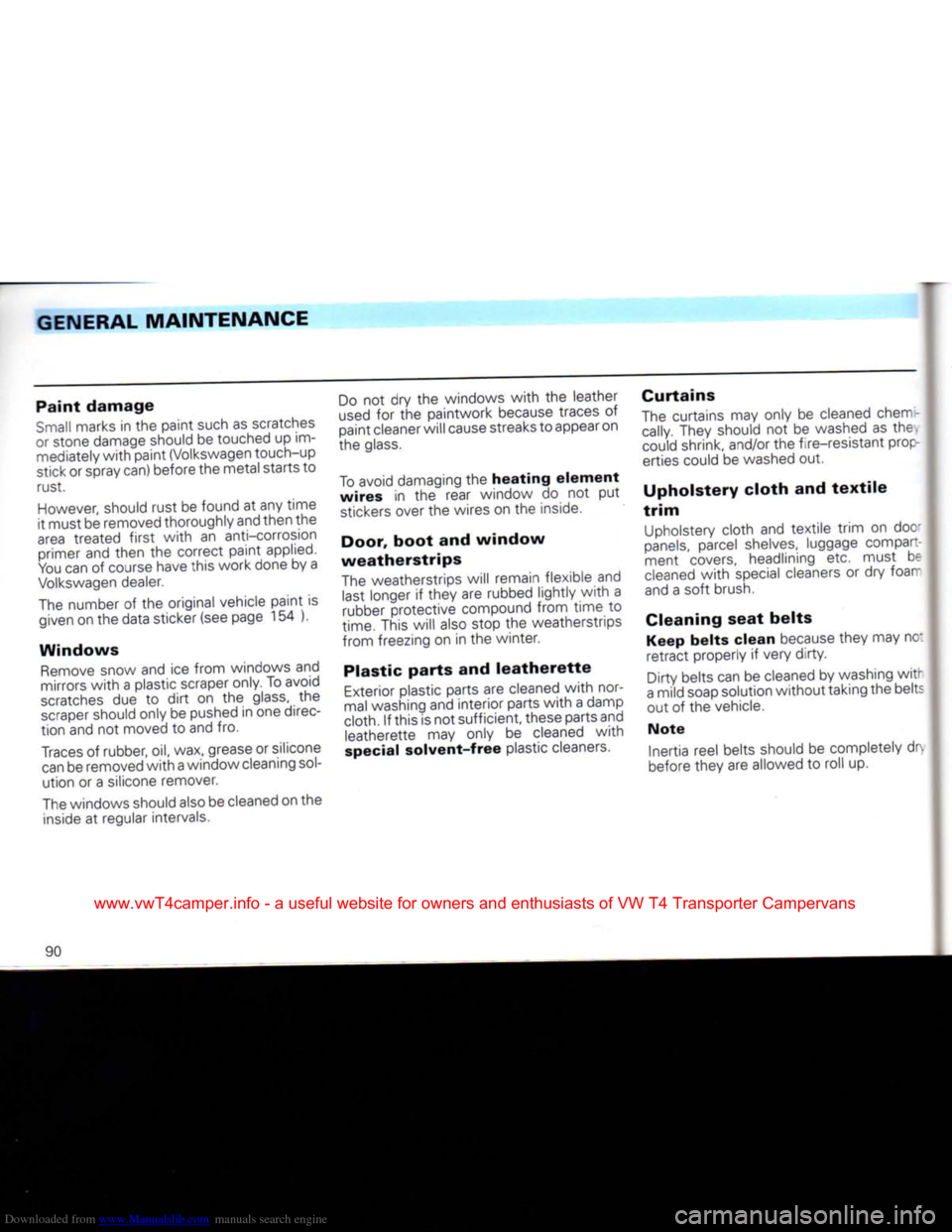
Downloaded from www.Manualslib.com manuals search engine
GENERAL MAINTENANCE
Paint damage
Small marks in the paint such as scratches
or stone damage should be touched up im mediately with paint (Volkswagen touch-up
stick or spray can) before the metal starts to rust.
However, should rust be found at any time
it must be removed thoroughly and then the
area treated first with an anti-corrosion primer and then the correct paint applied.
You can of course have this work done by a
Volkswagen dealer.
The number of the original vehicle paint is given on the data sticker (see page 154 ).
Windows
Remove snow and ice from windows and
mirrors with a plastic scraper only. To avoid
scratches due to dirt on the glass, the
scraper should only be pushed in one direc
tion and not moved to and fro.
Traces of rubber, oil, wax, grease or silicone
can be removed with a window cleaning
sol
ution or a silicone remover.
The windows should also be cleaned on the inside at regular intervals. Do not dry the windows with the leather
used for the paintwork because traces of
paint cleaner will cause streaks to appear on
the glass.
To avoid damaging the
heating element
wires
in the rear window do not put
stickers over the wires on the inside.
Door, boot
and
window
weatherstrips
The weatherstrips will remain flexible and last longer if they are rubbed lightly with a
rubber protective compound from time to
time.
This will also stop the weatherstrips
from freezing on in the winter.
Plastic parts
and
leatherette
Exterior plastic parts are cleaned with nor
mal washing and interior parts with a damp
cloth.
If this is not sufficient, these parts and leatherette may only be cleaned with
special solvent-free
plastic cleaners.
Curtains
The curtains may only be cleaned chemi cally. They should not be washed as the.
could shrink, and/or the fire-resistant properties could be washed out.
Upholstery cloth
and
textile
trim
Upholstery cloth and textile trim on doc-
panels, parcel shelves, luggage compart ment covers, headlining etc. must be
cleaned with special cleaners or dry foarr
and a soft brush.
Cleaning seat belts Keep belts clean
because they may nc:
retract properly if very dirty.
Dirty belts can be cleaned by washing with
a mild soap solution without taking the belt; out of the vehicle.
Note
Inertia reel belts should be completely dr.
before they are allowed to roll up.
90
www.vwT4camper.info - a useful website for owners and enthusiasts of VW T4 Transporter Campervans